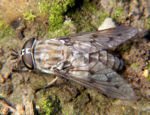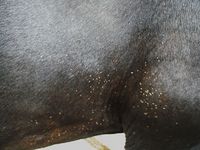Gasterophilus spp.
Jump to navigation
Jump to search
- Also known as the horse bot fly
Introduction
The species Gasterophilus, is more commonly referred to as the 'Bot fly.' It is an obligate parasite found on horses, donkeys, mules, zebras and elephants.
Infection is particularly common in horses, with around 30-60% infected during the winter months.
Scientific Classification
| Kingdom | Animalia |
| Phylum | Arthropoda |
| Class | Insecta |
| Order | Diptera |
| Family | Oestridae |
| Genus | Gasterophilus |
Life Cycle
- Obligate parasites of equids
- Spend most of life cycle in the equine stomach
- Of little pathogenic significance
- Three important species (in the UK)
- G. intestinalis which is the most common
- G. nasalis
- G. haemorrhoidalis which is rare
- Two other important veterinary species
- G. nigricornis
- G. inermis
Identification
- Medium to large flies at 10-20mm long
- Look similar to drone bumble bees
- Body covered with dense yellow hair
- Dark coloured hairs produce a banding pattern
- Clear wings with brown patches
Life cycle
- Adults are most active in late summer
- Eggs are laid on the body and hatch spontaneously or are stimulated to hatch through an increase in warmth and moisture from the animal self-grooming. They are laid in different areas according to species
- G. intestinalis eggs are laid in the hair of the shoulders and fore legs
- G. nasalis eggs are laid in the intermandibular area
- G. haemorrhoidalis eggs are laid around the lips
- Creamy-white eggs
- 1-2mm in length
- Larvae crawl into the mouth and penetrate the tissues of the tongue and buccal mucosa
- Larvae then emerge after a couple of weeks and are swallowed
- Larvae pass into the stomach and attach to the gastric mucosa
- Larvae are now known as bots
- Each species attaches to a specific part of the stomach
- G. intestinalis attaches to the cardiac region
- G. nasalis attaches to the pylorus
- After 10-12 months in the stomach, the larvae detach and are passed out in the faeces
- G. haemorrhoidalis attaches to the rectal mucosa before being passed out
- Larvae pupate on the ground
- Adults hatch after 1-2 months and survive from a few days to 2 weeks
- Adults have non-functional mouthparts so cannot feed
- There is only 1 generation per year in temperate regions of the world
Pathogenesis
- Adults cause annoyance when egg laying
- Disturbance and panic can ensue
- Larvae cause a marked inflammatory reaction when attached to the gastric mucosa
- Ring like thickening around the base of each attached larvae
- Large numbers of larvae may interfere with the passage of food and action of gastric sphincters
- G. haemorrhoidalis can cause mild irritation to the rectal wall
- Host reaction to larvae in the mouth is minimal
Control
- Treatment of horses with insecticides over winter
- Breaks the life cycle as all the population are present as bots in the stomach
- If eggs are present in late summer, the horse's coat can be sponged with an insecticide
- Stimulates hatching
- Kills larvae

